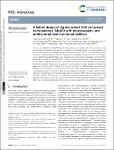Search
Author
- Hoang, Van Tuan (2)
- Nguyen, Thi Hue (2)
- Nguyen, Tien Khi (2)
- Anh, Tuan Le (1)
- next >
Subject
- Zno (2)
- Antibiotic (1)
Has File(s)
Search Results
In this work, Ag@ZnO and Ag@ZnO/MgAC photocatalysts were synthesized using a simple two-step electrochemical method by the addition of magnesium aminoclay (MgAC) as a great stabilizer and a Lewis base, which could donate electrons for reduction of Ag+ and Zn2+ ions, facilitating uniform formation as well as effective inhibition of aggregation of Ag@ZnO nanoparticles (NPs) on the MgAC matrix. Ag@ZnO and Ag@ZnO/MgAC were investigated for photocatalytic degradation of MB and their antibacterial efficiencies. Ag@ZnO/MgAC showed excellent photocatalytic MB degradation with a performance of 98.56% after 80 min of visible-light irradiation and good antibacterial activity against Salmonella (Sal) and Staphylococcus aureus (S. aureus) bacterial strains, providing promising high application p... |
In this study, we have developed, for the first time, a colorimetric and surface-enhanced Raman scattering (SERS) dual-mode sensing platform for sensitive amoxicillin (AMX) detection by employing electrochemically-synthesized copper nanoparticles (CuNPs) and copper-graphene oxide (Cu-GO) nanocomposites with low cost and high purity. The obtained results revealed that Cu-GO-based colorimetric nanosensor exhibited high sensitivity with AMX antibiotics in a linear working range from 5 to 50 µM with a limit of detection (LOD) of 1.71 µM, which was 1.3 times lower than that of CuNPs-based colorimetric nanosensor (2.17 µM). More interestingly, Cu-GO-based SERS nanosensor has a linear range from 0.01 to 1000 µM and a LOD value ∼x223C 0.0012 µM, which was ∼x223C 13 times lower than CuNPs-ba... |
In this work, Ag@ZnO and Ag@ZnO/MgAC photocatalysts were synthesized using a simple two-step electrochemical method by the addition of magnesium aminoclay (MgAC) as a great stabilizer and a Lewis base, which could donate electrons for reduction of Ag+ and Zn2+ ions, facilitating uniform formation as well as effective inhibition of aggregation of Ag@ZnO nanoparticles (NPs) on the MgAC matrix. Ag@ZnO and Ag@ZnO/MgAC were investigated for photocatalytic degradation of MB and their antibacterial efficiencies. Ag@ZnO/MgAC showed excellent photocatalytic MB degradation with a performance of 98.56% after 80 min of visible-light irradiation and good antibacterial activity against Salmonella (Sal) and Staphylococcus aureus (S. aureus) bacterial strains, providing promising high application p... |


